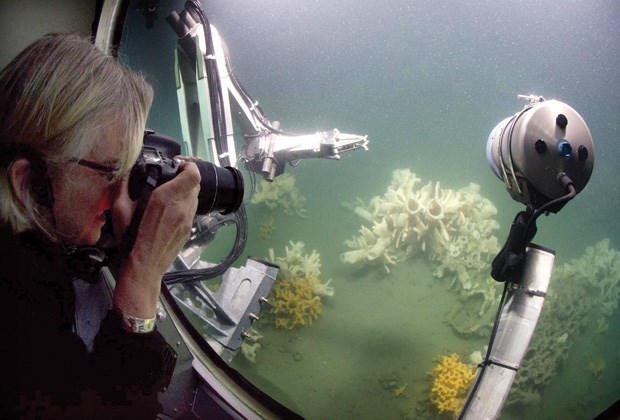A group of international scientists and conservationists travelled deep below the ocean’s surface off West Vancouver and Howe Sound this week, exploring some extraordinary glass sponge reefs.
The glass sponge reefs are made by creatures that date back to the Jurassic era and are so rare in the world, until recently, they were thought to be extinct.
When scientists confirmed the existence of the reefs deep in B.C. waters, it was like discovering “a herd of dinosaurs”, said Sabine Jessen, oceans director with the Canadian Parks and Wilderness Society, who lives in North Vancouver.
This week, the conservation group partnered with the North Vancouver submersible firm Nuytco Research to lead an expedition to the reefs, found in about 75 metres of water near Passage Island.
From a mini submarine, they filmed the intricate tubular structures of the reefs, which are created by the prehistoric sponges, and vaguely resemble coral reefs.
The glass sponge reefs, made out of silica, are unique to B.C., said Jessen, because “there are very few places in the world that have so much dissolved silica.”
In some places, like northern waters of Hecate Strait where the reefs are found as deep as 200 metres, the reefs can reach 14 metres in height — the height of a five-storey building, she said.
Jessen said the glass sponge reefs play an important role in the marine ecosystem. They provide habitat for other creatures like crabs, prawns and juvenile rockfish. On the submersible dives this week, “We saw lots of little flat fish” on the reefs, she said.
The sponges also keep the ocean clean by feeding on bacteria. “They filter enormous amounts of seawater,” she said.
But Jessen said the glass sponge reefs are also under threat, from bottom trawlers dragging for bottom feeders, as well as long line fishing, prawn and crab fisheries.
The reefs are “very brittle…like hard meringue,” she said. “They’re not strong. If anything hard touches them, they just crumble.”
Fishing near the bottom of the ocean also stirs up sediments that can cover and kill the sponges.
On the north coast, where sponge reefs were first discovered in Hecate Strait in the late 1980s, the Department of Fisheries and Oceans closed the areas near to the reefs to many types of fishing in 2002.
Jessen said conservationists are now pushing for similar measures and long-term protection for all of the glass sponge reefs, including those in local waters.
Because they are such productive habitat for other species, “The sponge reefs should be among the first places we protect,” she said.



